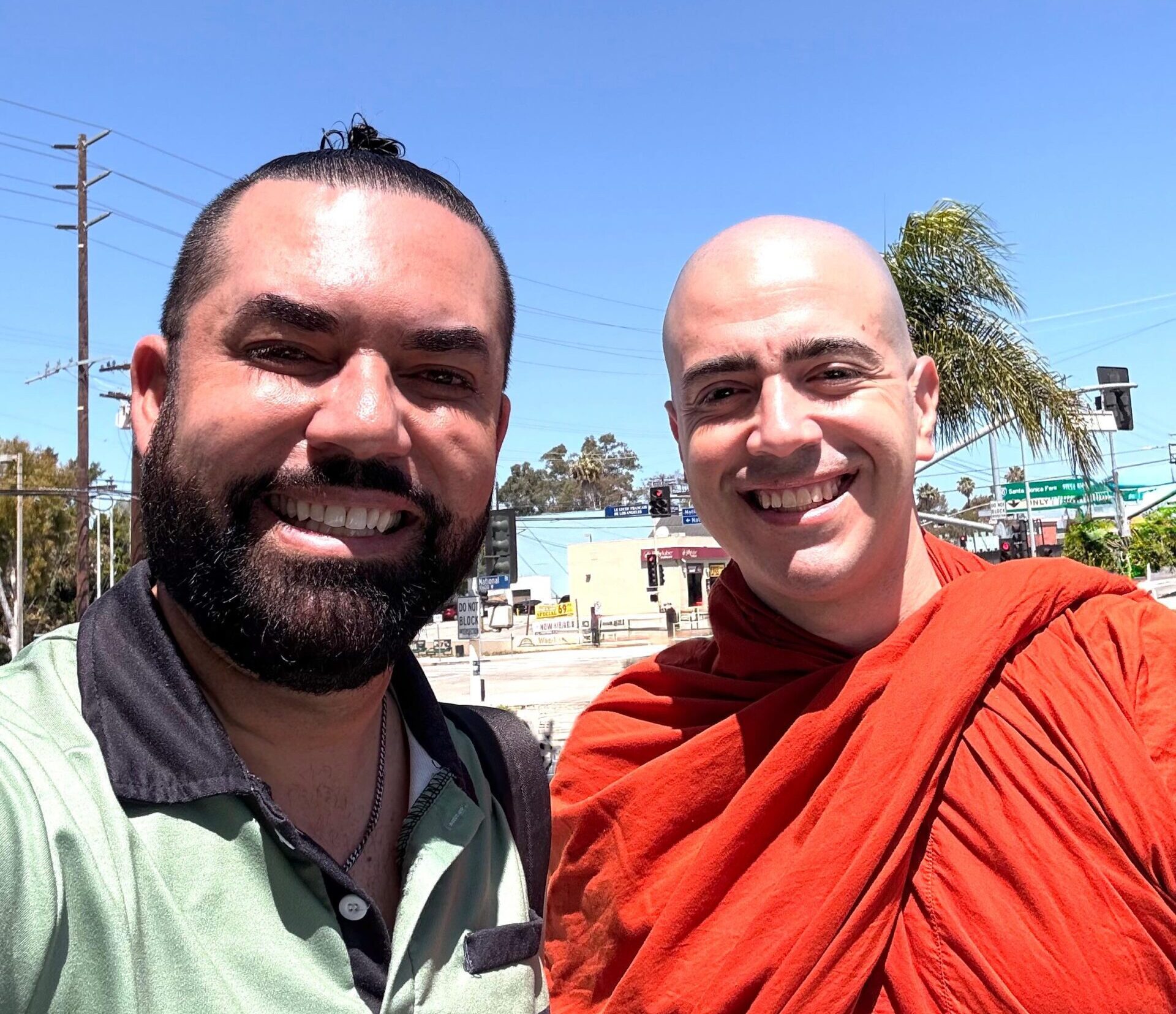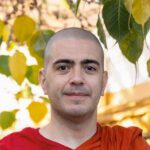Sanathavihari Bhikkhu and Carlo Carranza join Buddhadharma’s Mariana Restrepo to discuss the growth and influence of Buddhism within Latinx communities. Sanathavihari is a Mexican-American monastic in the Theravada tradition, while Carlo Carranza, born and raised in Mexico, is a dharma teacher in the Tibetan tradition. Together, they offer a meeting point between different Buddhist lineages and lived Latinx experience, highlighting both the challenges and opportunities of sharing the dharma in vibrant, multilingual communities.
What was it about Buddhism that first spoke to you personally, and how did it connect with your experience as a Latinx?
Sanathavihari Bhikkhu:
For many Latinxs, the path to Buddhism begins with a deep search for healing, meaning, and community. I found the teachings of the Buddha to be compassionate, practical, and open to all. Buddhism offered tools to navigate suffering, not by suppressing it or offering salvation, but by truly understanding it.
As a Latino, I also found that Buddhism didn’t ask me to abandon my cultural background; it welcomed my experience as part of the journey. Until we are awakened, we cannot know if a sutta is what the Buddha said or not. However, as the Buddha said, valid experience is the highest form of authority. I also believe that many indigenous peoples of the Americas and Africa had their cultures, including religion/spiritualities, suppressed and taken from them by the European colonial powers. Many Latinos to this day are still feeling the impact of this loss, a disconnection, and Buddhism can offer a spiritual path to fulfill that longing for our ancient religious/spiritual practices.
“Latinx culture is rich, layered, and expressive, bringing vitality. In fact, the Buddha often encouraged his followers to uphold their ancestral traditions. Bridging these worlds is not a compromise; it is a natural process.” —Sanathavihari Bhikkhu.
Carlo Carranza:
I was drawn to Buddhism when I saw how realistic and practical the Buddha’s words were. I could see for myself that what he taught was true. The teachings about suffering, its causes, and the possibility of freedom made deep sense to me, especially when paired with the wish to help others.
For many Latinx, who grow up in families where caring for others is important, the path of a bodhisattva feels very natural. We’re taught to give, to serve, and to care. Buddhism gave me a way to guide that natural instinct with wisdom. It also helped me look beyond labels and explore my inner world more deeply. Ultimately, we all desire happiness and seek to avoid suffering; this fundamental truth is what the Buddha shared in his very first teachings.
How do you navigate and express both your Latinx cultural roots and your Buddhist practice — and do you see them as blending, bridging, or simply coexisting?
Sanathavihari Bhikkhu:
It’s not about choosing one or the other, as Buddhist practice doesn’t require adopting an Asian ethnic culture. I chant in Pali, but I also share teachings in English and Spanish. I sit in silence, but I carry the rhythm of my culture in my blood. I used to like cumbias and reggaeton a lot. Latinx culture is rich, layered, and expressive, bringing vitality. In fact, the Buddha often encouraged his followers to uphold their ancestral traditions. Bridging these worlds is not a compromise; it is a natural process.
Carlo Carranza:
I think that being Buddhist isn’t about mixing cultures; it’s about recognizing that the teachings transcend any particular culture. Still, culture can help us relate to the dharma more easily. It’s like cooking a traditional Mexican dish; you can use the same five ingredients: cheese, corn, meat, salsa, and beans, but depending on how you put them together, you get a taco, quesadilla, burrito, enchilada, or even a chimichanga. The ingredients are the same, but the way they’re arranged makes it feel more familiar. Similarly, cultural style can help the teachings feel more familiar. For instance, Latinx are recognized for our passion and energy in connecting and accomplishing tasks, qualities that, when guided by wisdom, can serve as a tremendous strength.
How does the deep value of ‘la familia‘ (family) in Latinx culture shape the way you relate to sangha and community in Buddhist practice?
Sanathavihari Bhikkhu:
Latinx families are often tight-knit. For many of us, “la familia” extends far beyond the nuclear household. In Buddhism, the idea of sangha, the community of practitioners, mirrors this. When I became a monk, my sangha became my family, the foundation where we cultivate attitudes such as patience, compassion, and service. This is exemplified by the story found in the Vinaya in which the Buddha exhorts the monks to take care of each other since they no longer have any families: “Monks, you have no mother or father to care for you. If you do not care for one another, who will? Whoever would care for me, let them care for the sick…. It is the responsibility of the community to look after the sick.”
Carlo Carranza:
This has become a powerful bridge when introducing the dharma to Latinx. The path of compassion and wisdom is not an individualistic escape. Even when I was a monk, I knew it was a way to become a better person for my community, my family, and all sentient beings.
For many Latinx practitioners, looking for support and companions on a path feels very familiar. In many Latin American cultures, there’s a deep value placed on community, family, and mutual care. People often turn to loved ones, neighbors, and faith communities for strength and guidance. So, when they come to Buddhism and discover the importance of the sangha, the community of fellow practitioners, it often feels like something they already understand: walking together, supporting one another, and not having to face life’s challenges alone. We understand what it means to be part of something larger than ourselves. The sangha, as an object of refuge, offers the support we need to develop the inner qualities already within us.
How have you navigated your Christian or Catholic roots alongside your Buddhist practice, and what have you discovered in that process?
Sanathavihari Bhikkhu:
My mother and father weren’t very devout Catholics, so switching to Buddhism didn’t cause any religious conflicts at home. I carry gratitude for what I received from my grandmother’s tradition: faith, sacrifice, and a concern for the less fortunate. Buddhism actually helped me understand Catholicism and learn a new appreciation for the deep devotion that many Latinx have. I can vividly recall my grandmother reciting her rosary early in the morning and before bed each night, regardless of her own health or the coldness of the morning. At the beginning of my Buddhist journey, I had a slight aversion to devotion, but after understanding the importance of faith and reverence in Buddhism, I was better able to not only understand my grandmother’s devotion but also see her as a role model for my own devotional practice. Latinx in the U.S.A. are used to walking between worlds; this is just another crossing, another way of seeking truth.
Carlo Carranza:
My family wasn’t very religious, but I grew up knowing that we had a cultural connection to Catholicism. Even if we didn’t go to church all the time, I was still surrounded by Catholic traditions, values, and ways of thinking. When I began practicing Buddhism, I started to see things differently. Letting go of certain beliefs from my past wasn’t always easy, but it helped me grow. It felt like a step toward becoming more open-minded and understanding things more deeply. Sometimes, letting go isn’t about rejecting the past, it’s about making space for new ways of seeing and living. Many Latinx Buddhists still pray with their families, attend religious events like weddings, or take part in holidays like Christmas dinner. There is wisdom in both traditions. What matters is living ethically, with awareness, and cultivating compassion. Buddhism teaches us to let go of labels while remaining aware of our origins.
Reverence for elders is a central aspect of Latinx culture — how does this value shape your understanding of lineage and gratitude in your Buddhist practice?
Sanathavihari Bhikkhu:
In Latinx culture, respect for elders and honoring ancestors is a common tradition. Buddhism honors this deeply through its emphasis on lineage, teachers, and gratitude. For example, in the Sigalaka Sutta, the Buddha emphasizes the importance of preserving our traditions: “I will maintain the family lineage and tradition.” In fact, the Mahaparinibbana Sutta states that some of the signs of a declining nation are when they stop showing “respect, honor, esteem, and veneration towards their elders and think it worthwhile to listen to them.”
When I bow to the Buddha or to my teacher, I also bow to my ancestors, who made my path possible. This sense of veneration strengthens the practice. In fact, in many Buddhist traditions there are holidays dedicated to honoring our elders, for example in the Vietnamese Pure Land tradition there is the Vu Lam ceremony, a holiday based on the Ulambana Sutra that was originally focused on honoring our dead parents by dedicating our meritorious actions to them, however, in the modern Vietnamese context it has also incorporated honoring one’s mother in this life. In Sri Lanka, many Buddhists often bow or even do a full prostration to their parents, grandparents, and teachers on holidays or special events like graduations.
Growing up, I was introduced to the Mexican practice of kissing my uncle’s hands as a sign of respect. At the time, it was a strange practice for me, but now with a Buddhist understanding, I have learned to appreciate it and also how sweet of a gesture it was. Additionally, in Mexico, we celebrate our departed relatives on Día de los Muertos. Although this holiday was not practiced by my family, it was practiced by some of my other Mexican friends and people in my community. Similarly, looking back at it now as a Buddhist, I see the many parallels that it shares with the Vietnamese Vu Lam ceremony.
Carlo Carranza:
We are not self-made. In Buddhism, connection to lineage isn’t just formal; it’s a transmission of values and realization. For Latinxs, remembering where we come from is a natural inclination. At the same time, there is sometimes an assumption that gratitude should come automatically just because someone is older or part of our family. That expectation can be overstated in Latinx cultures and some Asian cultures as well. The challenge is that mainstream Western Buddhism often overlooks this relationship altogether. We need to reintroduce rituals and stories that speak to our hearts, while remaining rooted in the confidence that the teachings themselves bring.
How do language, culture, and representation shape accessibility and belonging within the Buddhist sangha for Latinx practitioners?
Sanathavihari Bhikkhu:
Spanish-language dharma resources are still limited. [View Lion’s Roar’s selection of Spanish-language dharma.] Many Latinx want to explore Buddhism but find only English materials or Asian cultural contexts that they may struggle to connect with. We need teachers like us, who have lived the Latinx experience, who know how it feels not to completely connect with the religion of our parents and our ancestral nations. Accessibility matters, speaking the language and knowing the lived experience of Latinx begins to break down the many obstacles that Latinx face in exploring the dharma.
Additionally, we need more Mexican teachers, including indigenous Mexican teachers and Afromexican teachers, etc., because Latinx are not a monolith, and neither are Mexicans. We should do our best to promote better representations of Latinx in the dharma and not be misled into thinking that I, a Mestizo, can fully understand or represent the diverse Latinx community experience.
The Buddha’s teachings are for all beings. A true sangha includes diversity of nation, culture, and language. I have sat beside Sri Lankan monks, Vietnamese monks, White monks, Latinx Americans, Black Americans, and Asian American devotees. I am reminded of the Buddha’s words in the Vasettha Sutta when he acknowledges the distinct differences among animals but then states that “In human bodies as they are, such differences cannot be found: the only human differences are those in names alone.” In humanity, in the sangha, we are all one people, one family, one big sangha. While we all share the same human existence, our understanding of life is shaped by the unique contexts and experiences we come from. That’s why it’s essential for the dharma to be communicated in ways that reflect those diverse realities. For Latinx communities, this means not only making the teachings available in Spanish, Portuguese, and other languages but also ensuring that these teachings are shared and taught by those who understand the lived Latinx experience. Simply translating materials from English, Japanese, or Thai is not enough—the dharma must also be transmitted from within our own cultural perspective to truly resonate.
Carlo Carranza:
Representation in Buddhism shouldn’t be about ego or just promoting culture; it should be based on wisdom, and that leads to inclusion. Recognizing someone’s background, like their language or culture, can create a connection and trust. When I translate teachings or give talks in English or Spanish, I often see people relax, like something finally makes sense, and it feels familiar. In this way, culture can serve as a bridge to the teachings. Language and culture are part of relative truth, but they can be powerful tools to help people access the dharma.
As Buddhism spreads across the world, it should reflect the diversity of the people who practice it. That means not just allowing differences, but appreciating them. A sangha that welcomes different expressions of the dharma doesn’t just become more inclusive, it becomes more alive.
The Buddha taught that all beings are equal in a very important way, we all want to be happy and avoid suffering. From this perspective, the differences between cultures or races are relatively minor. Even science tells us that all humans share 99.9% of the same genetic code, the identities we cling to are mostly surface-level. Holding tightly to these identities, whether personal, cultural, or social, can become a source of suffering. It’s easy to get attached to being praised, being seen a certain way, or avoiding criticism, even after years of practicing the dharma. Part of the path is learning to see how shifting and relative all identities are.
How have you navigated embracing both your Latinx cultural identity and Buddhist practice, and what does bridging these worlds mean to you?
Sanathavihari Bhikkhu:
As someone raised in the U.S., I grew up not only navigating my American and Mexican identities but also those of my friends and romantic partners. I grew up in a culturally and racially diverse community and was often taken in by and incorporated many aspects of other communities that shared their cultures with me. Additionally, during my time in the United States Air Force, I also had to adapt my cultural identity to the Air Force’s culture. Therefore, when I came to the dharma, I already had much personal experience in navigating and incorporating diverse identities.
Buddhism does not come with any particular racial, national, or ethnic identity; also, it is true that each tradition of Buddhism comes with its own culture (tradition). I did not struggle with incorporating the Buddhist identity and culture/tradition, although I did struggle a bit navigating Sri Lankan culture, which is something separate from Buddhism, as there are also Catholic, Hindu, and Muslim Sri Lankans who are part of Sri Lankan culture. All of this to say is that I don’t see and neither did I experience any clash between Buddhism and being Mexican-American. For me Buddhism is a different type of identity that is not at odds or even on the same level as my national, racial, or ethnic identities.
Carlo Carranza:
Buddhism is taking root in Latinx communities as a vibrant and growing expression of timeless wisdom. As someone who has worked in education for many years, I’ve come to believe that while the dharma is available to everyone, it must be presented in a way that meets people where they are. This is not about simplifying the teachings, but about offering them in a way that is accessible and grounded.
Many Latinx, as well as people in general, are deeply drawn to the profound teachings of the Vajrayana. However, this often happens without a basis in the foundational teachings shared across all traditions, which can lead to confusion or misinterpretation. To offer a comparison from the field of education, mathematics is a verifiable science, and advanced topics like inferential calculus aren’t reserved for a special elite. But if someone attends a university-level calculus class without knowing how to add or subtract, they’ll likely sit there overwhelmed, watching the professor write complex formulas on the board and thinking, “These people are crazy, I don’t understand a thing!” The subject is valid and serious, but without the basics, it could be incomprehensible.
This same challenge arises when people attempt to engage in advanced practices without first developing a solid basis in the foundational teachings. We can inspire many people by sharing the dharma authentically, without diluting it. There’s no need to strip it of its traditional framework or secularize it beyond recognition. Teachings on cause and effect, impermanence, dukkha, emotions, and interdependence speak directly to the human experience, regardless of cultural background. The path may not always be easy to understand or follow, but it is deeply meaningful. Walking it and sharing it with others is one of the most rewarding aspects of practice.




